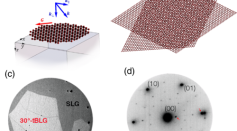Tags: Graphene

ERDC Partners With Multiple Universities on Graphene Research

Indium in Mobile Phone, Television Screens: New Study Reveals How Graphene Could Replace Unique Metal Used in Electronic Devices
COVID-19 Vaccines Deadly? Experts Debunk Fake News That Jabs Contain Graphene and Magnetism

2D Quantum Confinements Developed Through Twisting Nanoscale Bilayer Graphene
Atom Bonding, Nature Measured Using Ultrasound in Nanometer Showing That Sound Speed Is Dependence on Structure

Gold Nanoparticle Behavior at the Edge of Graphene Sheets Sparks Major Implications For Quantum Devices
New Form of Carbon Only One Atom Thick, Ideal for Future Electronics, High-Tech Engineering

Ultraflat Biphenylene Carbon Sheet Set to Revolutionize Electronics

MXenes Aids in Photostimulation of Neurons, Hosts Numerous Benefits for Treating Neurological Diseases
Janus Graphene: Asymmetric, Two-Faced Material Could Turn Sodium-Ion Batteries Into Sustainable Energy Storage
Most Perfect Graphene: Single-Crystal Specimen Has No Wrinkles, Folds, Adlayers

Experts Developed New Approach To Observe How Ions Get Missing Electrons During Solid Material Penetration

New Antibacterial Technique for Surgical Implants Innovated Through Graphene and Acid Binding
Hexagonal Boron Nitride Dubbed the Toughest 2D Materials, Here's Why

Ice Formation on Graphene Shows the Need for Heat
2D Material More Than Just Graphene; 'Nanomesh' Developed for More Efficient Quantum Communications
It’s a Kind of Magic! Researchers Make Versatile Quantum Devices Out of Graphene
Graphene Fabricated Into Nanoribbons May Replace Fiber Optics, Improve Tech Applications
New Graphene 3D Printing Technique Makes Feasible Water Filters
Freezing Electrons as Temperature Rises: Discovered Graphene System Does That!
Most Popular

10 Weird Things the Human Body Does—and the Science Behind These Biological Mysteries

Top Space Technology Trends and Aerospace Innovations Revolutionizing the World Today

Why Mega Typhoons Keep Getting Stronger: The Science Behind Typhoon Formation and Extreme Weather

How Plate Tectonics Trigger Earth's Most Dangerous Disasters Through Powerful Seismic Hazards




